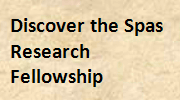 |
|||
|
|
|||
|
||||||||||||||||||||||||||||
|
P R O F I L E |
||||||||||||||||||||||||||||
|
 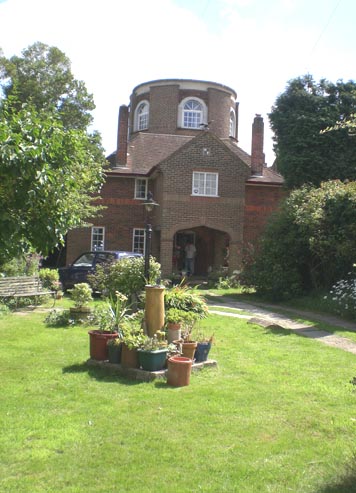
Tadworth Water Tower and its environsTower HouseTower Road Tadworth Surrey United Kingdom KT20 5QY Abreviated text version by Dr Bruce E Osborne of Tower House. First published in 1996 and revised in 1998 to celebrate a century of Tadworth Tower. The North Downs Location The Tower House in Tower Road, (formerly Middle Road) Tadworth is now a distinctive residence. It started life as a water tower for the Sutton District Water Company who built it in a Victorian Romanesque style in 1898. It was an essential provision for a district that was rapidly developing at the time. Although the Tower was essentially an industrial building, it was also a prominent tourist landmark on the edge of Walton Heath. 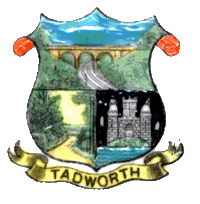
The background to tourism interest was that in the previous year the Chipstead Valley Railway, incorporated by Act of Parliament in 1893, had opened to Kingswood Station. The Act gave powers to build a line between Purley and Walton on the Hill. As the line was extended, Tadworth railway station was opened on 1st July 1900 as "Tadworth and Walton on the Hill". As a result the locality became prime development land as well as a venue for excursionists who dispersed over Banstead, Walton and Headley Heaths. A characteristic feature of the local heaths and the land upon which the tower was built is that the surface geology comprises clay with flints of Pleistocene and recent origin overlying the Upper Chalk of the Cretaceous period. This gives the heath a distinct bio-diversity and topography. 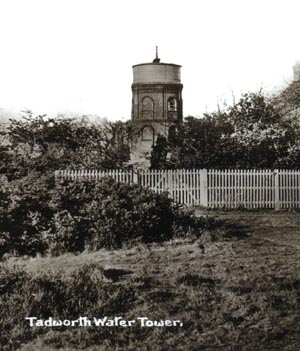 Picture: This was the Tower that ramblers would walk to from the newly opened station of Tadworth and Walton on the Hill.
Picture: This was the Tower that ramblers would walk to from the newly opened station of Tadworth and Walton on the Hill.
Colley Hill, on the nearby south-facing escarpment of the North Downs, became popular in the 19th century, together with the more distant Box Hill. The latter venue had a long-standing reputation for diversion and debauchery. The Earl of Arundel, during the reign of Charles I (1625-1649) is reputed to have brought Box trees from Kent and planted them on White Hill, later renamed, although evidence exists to suggest that Box trees on the hill predated this. In the 18th century, the Box Wood was considered the best in the Kingdom. Mackay (1714) observed that "Gentlemen and Ladies insensibly to lose their company in the pretty labrynths of Box-wood and divert themselves unperceived....and it may justly be called The Palace of Venus". Celia Fiennes, c.1692, noted Box Hill as a diversion for visitors to "Epsum Spaw" and Daniel Defoe, 1724/6, saw the walks laid out by the Earl of Arundel as a place to divert or debauch, or both. The Health Resort Tadworth in the 18th century enjoyed a different type of reputation and is described by Aubrey as "famous for its wholesome Air, once perscribed by Physicians as the patients last refuge or Ultimum Refugium". Perhaps as a reaction to the earlier excess associated with Box Hill, by 1905 Tadworth sported a Temperance Hotel, run by Mrs Effie Smith. 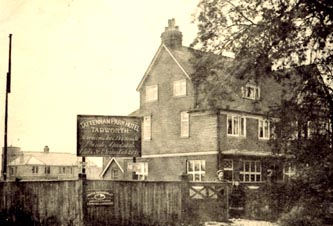 Walkers were attracted to Tadworth by the healthy scent from the pine trees that grew in profusion together with the bracing air of the North Downs. The district was sparsely populated and the Tower, as a landmark, was featured extensively on post cards of the era. Walkers were attracted to Tadworth by the healthy scent from the pine trees that grew in profusion together with the bracing air of the North Downs. The district was sparsely populated and the Tower, as a landmark, was featured extensively on post cards of the era.
Charles Ford in his guidebook of c.1910 described the area as "The Highlands of London" being upwards of 600 feet above sea level. Ford noted that physicians of London sent patients here at that time. He quotes one such doctor who believed that "Tadworth was the healthiest part of England". Picture above: The Temperance Hotel - the water tower, later Tower House, can be seen botton left behind the flag pole in the background. The sign includes an advertisement for Teas at 9d per cup (4p). One of the notable tourists to the area was the renowned poet Rupert Brooke, just before World War I. Phyllis Gardner was his girl friend who lived in Tadworth. Arriving by train, Rupert would join her on long rambles over the heath and up to Colley Hill. The love story is recorded by Lorna Beckett in her book "The Second I Saw You" (2015) published by British Library. Tourist Souvenirs A trade in tourist souvenirs developed alongside the travel and refreshment facilities. Armorial china was a popular recreational tourism keepsake. Two Tadworth retailers sold such souvenirs, W.Gates at The Bazaar and Simpson of The Paragon (later the Willow Cafe). Items included a charabanc, which suggested that the railway was not the only mode of transport for the visitors, and Epsom Clock Tower (built 1848), indicative of the importance of Epsom as the nearest town. 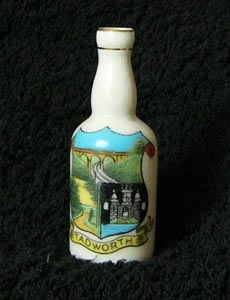
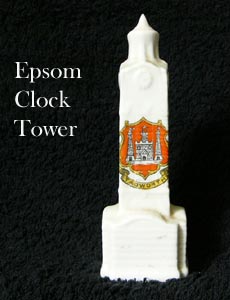
Tadworth had no official coat of arms and one was contrived in due course. The use of the castle from the County armorial on a model of Epsom clock tower suggests that this may be an earlier item and that later a more complex design was created. With the coming of the railway, the deep cutting and Tadworth Street bridge were notable features and were depicted on a new contrived arms, together with a country lane, probably also Tadworth Street looking south, emphasising the rural aspect of the neighbourhood. Walton on the Hill similarly had a trade in designated armorial china. Enterprising local people set out to capitalise on the tourism. A mobile snack bar from this era survived for many years in Walton as a garden hut opposite the Chequers public house. Pictures above - Armorial or Crest China from the early 20th century. It was purchased in Tadworth as a souvenir by tourists seeking the healthy country air and open heaths of the North Downs. The Commons Walton Heath and Banstead and Epsom Downs were long established as local venues of outdoor recreation before the erection of the Tower. On 14 July 1667, Samuel Pepys records that he travelled by coach from London to spend the day at Epsom, taking the waters and walking on the Downs where he met a shepherd and lad with a sheep dog. For 4 shillings a week (20 new pence) the shepherd tended 18 score sheep the year round. Aubrey (1718/9) noted that Banstead Downs was famous for its wholesome air and was well renowned for mutton. Gilpin, in contrast, on his August excursion of 1768 recorded Walton Heath as "a wild and desolate view. Nothing can be more dreary, and comfortless. A solitary wind mill and a spire tell you that the country is inhabited." This was Tadworth Mill and Walton Church as they were then. Banstead Downs or Commons today form an important recreational facility. To the south of the Tower lie two adjacent areas of open common land with freedom to roam. Immediately to the south is Banstead Heath, the largest of the four separate areas, which aggregate to form Banstead Downs, and then further south lies Walton Heath. The other two areas are Epsom Downs and Banstead Down at Belmont. All of these areas have been threatened with enclosure in the past and the Banstead Commons were the subject of particularly pertinacious litigation between the years 1877 and 1889. In 1864, Mr Alcock, the Lord of the Manor, sought to enclose the four commons but abandoned the attempt due to local opposition. Following Mr Alcock's death in 1866, a further attempt of enclosure failed by his executors and his interests were sold to Sir John Hartopp in 1873. By 1876, Sir John had purchased sufficient commoners rights, almost regardless of costs, to prompt him to build a row of houses and enclose part of Banstead Heath under the Statute of Merton. This provides for the land to revert to private property if all commoners rights are extinguished, thereby enabling enclosure under common law. A newly formed Banstead Commons Protection Society set out to oppose such enclosure by securing commoners rights and commencing a suit against Sir John in 1877. Lord Egmont owned three of the four dependent manors of Banstead including South Tadworth and faced with possible damaging enclosure of adjacent land, he cooperated initially with Sir John Hartopp. There followed a maelstrom of litigation culminating in Sir John's legal advisers becoming insolvent and Sir John in turn facing ruin and bankruptcy. This prompted the new Lord Egmont to relinquish his loyalty to the Hartopp cause, which if successful, such loyalty would have been rewarded by extended land ownership. It then transpired that the commons had been mortgaged to two ladies, who on Sir John's bankruptcy, took possession of the commons and in turn pursued the suit for enclosure. It was in 1886 that the case finally came to court and the ruling was in general favour of the commoners, although the question of surface damage recently affected by the two ladies was left unresolved, pending an investigation into the amount of commons needed for commoners husbandry. Lord Egmont's substantial grazing rights proved of value in this argument and following an appeal, the claims of the commoners were vindicated on 21 Dec 1889. Horse Racing Horse racing on the Downs near Tadworth likely originated from the Royal patronage associated with Nonsuch Palace in nearby Ewell in the 16th century. The vast numbers of horses congregating at Epsom during the 17th century spa era inevitably led to the occasional wager and a straight race course was in use from Epsom Downs down to Carshalton. The tradition continues with the familiar horse shoe shaped racecourse. Epsom Downs is now the home of The Derby and a range of public seasonal racing events famous world wide. 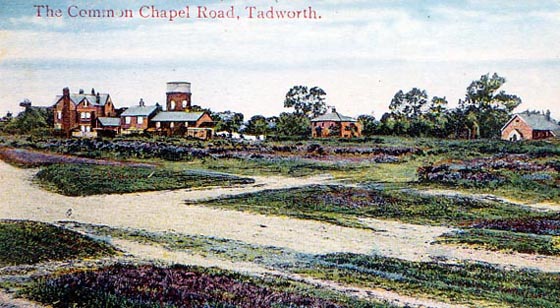
Picture: The Common circa 1910 showing the tower from the south-west. In 1893 the Banstead Commons became regulated under the Metropolitan Commons Act and thereafter were secured for all time. The adjacent Walton Heath however did not enjoy such protection and this was the subject of a determined effort at deregistration by the Walton Heath Golf Club, which had enjoyed use of the Heath, subject to commoners rights and public access under the Law of Property Act 1925. With the coming of the M25 motorway, the Club saw the opportunity of renegotiating the three remaining commoner's rights in exchange for a financial consideration. 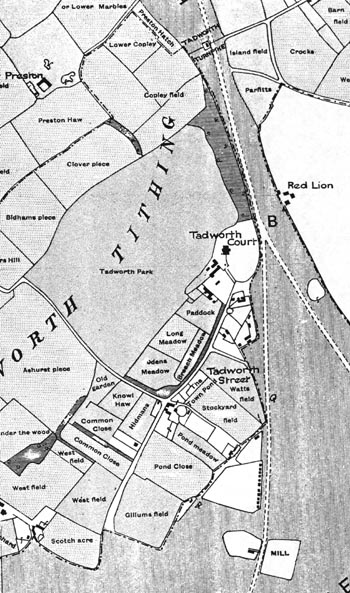 Rapid intervention by local residents intercepted the intention with the result that the Club could only secure one of the three rights of common. Once again efforts at deregulation had been thwarted.
Rapid intervention by local residents intercepted the intention with the result that the Club could only secure one of the three rights of common. Once again efforts at deregulation had been thwarted.
Map (right): Tadworth in the 19th century showing the Toll Gate or Turnpike and Tadworth Court - see Ancient Tadworth text below. The coming of the railway was to transform the landscape, as can be deduced from this mid 19th century map showing Gillums field where the tower was later built. The Railway The first scheme to bring the railway to Tadworth was an unsuccessful 1884 bill for a line through Chipstead promoted by local farmers. Cosmo Bonsor (born 1848), financier, director of the Bank of England and MP, together with J W Benson, a Bond Street jeweler and W S J Brown, a retired corn chandler shortly afterwards promoted an alternative scheme. This was based on connecting the London, Brighton and South Coast Railway branch to Epsom Downs with a branch line from Drift Bridge to Corner Farm, Tadworth. Although land values soared as speculators moved in, one opponent was Frederick Coleman of the mustard firm who owned land on the planned route. In spite of this the Epsom Downs Extension Railway Bill received Royal Assent in June 1892. The first sod was cut on 6 June 1892 but apart from this little work progressed. 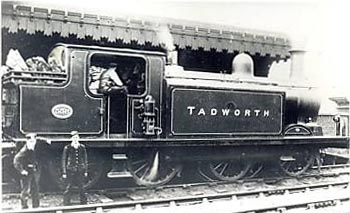 The reason was that Cosmo Bonsor had turned his attentions to the earlier Chipstead scheme as a means of avoiding local landowner opposition. Connecting with Purley, the Chipstead Valley Railway Act was approved in 1893. Bonsor joined the Board of the South Eastern Railway who operated through Purley, and was chairman by 1898. Work progressed with the new railway reaching Tadworth in 1900. The section of planned railway from Drift Bridge to Tattenham Corner was abandoned by Act of 1897 and Tattenham Corner eventually became the terminus for the Chipstead line. The extension of the railway to Tattenham Corner in 1901, for race and leisure excursions to Epsom Downs, enhanced the potential for outdoor recreation considerably. After 1899, the South Eastern and Chatham Railway Company operated the line and a free season ticket was offered for one year to London as an inducement to encourage residential traffic. Royal patronage of the Derby, traditionally visited by train, furthered the popularity of the locality.
The reason was that Cosmo Bonsor had turned his attentions to the earlier Chipstead scheme as a means of avoiding local landowner opposition. Connecting with Purley, the Chipstead Valley Railway Act was approved in 1893. Bonsor joined the Board of the South Eastern Railway who operated through Purley, and was chairman by 1898. Work progressed with the new railway reaching Tadworth in 1900. The section of planned railway from Drift Bridge to Tattenham Corner was abandoned by Act of 1897 and Tattenham Corner eventually became the terminus for the Chipstead line. The extension of the railway to Tattenham Corner in 1901, for race and leisure excursions to Epsom Downs, enhanced the potential for outdoor recreation considerably. After 1899, the South Eastern and Chatham Railway Company operated the line and a free season ticket was offered for one year to London as an inducement to encourage residential traffic. Royal patronage of the Derby, traditionally visited by train, furthered the popularity of the locality.
In 1997 a train was named 'Sir Cosmo Bonsor' in recognition of his services. The branch line to Tadworth would not have been viable without the pioneering London to Brighton railway, opened in 1841. To find out more click below.  ADDITIONAL INFORMATION To find Tower House - If you are driving, exit the M25 at junction 8 Reigate turnoff. Head towards London on the A217 for 3 miles through Kingswood. Tadworth is signposted left. Take this turning over Walton Heath. Cross the first cross roads into New Road and take the first right into Chapel Road. The first left into High Street and first left again into Tower Road. Look for the acorn gate posts. Alternatively Tadworth has a railway station with direct trains to and from London via East Croydon. Head up hill from Tadworth Station. Across the lights and Tower Road is second on the right. See map below. NEW IN 2015 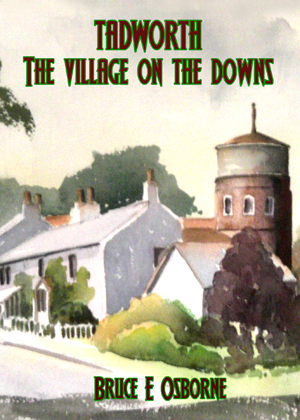 In 2015 an updated version of the compilation used on this web page was published in hard copy report format. 'Tadworth the Village on the Downs' was prepared in conjunction with the Tadworth Heritage and History Group and includes much more information about Tadworth generally. The document was prepared as a first stage in setting the scene for the establishment of a North Downs National Park. It is in A4 portrait format and includes many coloured pictures with about 70 printed pages. In 2015 an updated version of the compilation used on this web page was published in hard copy report format. 'Tadworth the Village on the Downs' was prepared in conjunction with the Tadworth Heritage and History Group and includes much more information about Tadworth generally. The document was prepared as a first stage in setting the scene for the establishment of a North Downs National Park. It is in A4 portrait format and includes many coloured pictures with about 70 printed pages.
Copies of this document can be secured from the author at Tower House. A nominal charge is made of 10.00 pounds sterling per copy to cover preparation and printing costs. In addition packing and postage is charged where relevant (allow 4.00 pounds sterling for UK). Subject to availability which is limited. Bibliography and further reading: Geological Survey of Great Britain, (1978) Sheet 286, Reigate, 1:50,000. Marshall W. (1818) County Reports of the Board of Agriculture, David and Charles reprint, p.380. Bowen E. (1753) An Accurate Map of the County of Surrey. Mackay J. (1714) A Journey Through England in Familiar Letter from a Gentleman Here to His Friend Abroad. 5th ed. 1732, Vol..i, p.140. Morris C. (1947) The Journeys of Celia Fiennes, Cresset Press, London, p.41. Cole G D H. (1927) A Tour Through the Whole Island of Great Britain by Daniel Defoe, Perter Davies, London, p.153/4. Aubrey J, (1718) The Natural History and Antiquities of the County of Surrey, Vol II, 1975 facsimile. Kohler and Coombes, Dorking, p.96. Eversley, (1910) Commons, Forests and Footpaths, Cassell, London, p.130-145. Murray J V. (1991) "Walton Heath Case Study", The Common Land Registration Act 1965, The Need for Reform, unpublished dissertation for Thames Polytechnic, p.49-70. Independent (1997) "New Train honours memory of Cosmo" 5 Nov. p.3. Osborne B E. Weaver C W. (1996) Rediscovering 17th Century Springs and Spas, In the Footsteps of Celia Fiennes, Cora Weaver, Malvern. Lambert H C M. (1912) History of Banstead in Surrey, Oxford Univ. Press, London, p.142,287. Surrey Record Office, 776/1-2 Sutton Advertiser Feb 5 & Aug 6 (1898) Detail noted from Tower House title deeds. Clew K R. (1968) Tadworth an Illustrated History, Chappell, Tadworth, p.13,27. Carder T. (1990) The Encyclopedia of Brighton, East Sussex County Libraries, p.210. Suckling E V. (1944) The Examination of Waters and Water Supplies, J & A Churchill, London, p368, no. 363. Sutton District Water Company archives and correspondence. Percy J (2001) In Pursuit of the Picturesque, William Gilpin's Surrey Excursion, Surrey Gardens Trust, p.15. Webb S (1995, 2002 ed.) Memories of Tadworth, Private Publication.. p.26/7. Bibliography and sources: Clark F L. (1954) NEW LIGHT ON EPSOM WELLS, Pullingers. Clew C. (1968) WALTON, AN ILLUSTRATED HISTORY, R J Chappell. Clew C. (1971) TADWORTH, AN ILLUSTRATED HISTORY, R J Chappell. DEBRETTS ILLUSTRATED PEERAGE, (1885) MacMillan, London. Denbigh K. (1981) A HUNDRED BRITISH SPAS, Spa Pubs. DICTIONARY OF NATIONAL BIOGRAPHY, (1931-40) Oxford University Press. Darwin B. (1952) JAMES BRAID, Batsford. Eversley Lord, (1910) COMMONS, FORESTS AND FOOTPATHS, Cassell & Co. Hembry P. (1990) THE ENGLISH SPA 1560-1815, Athlone. Home G. (1901) EPSOM, Homeland Ass. Hope A. (1919) BEAUMAROY HOME FROM THE WARS, Methuen. Huxford J F. (1982) THE ARMS OF SUSSEX FAMILIES, Phillimore. KELLYS DIRECTORIES. Latham R. (1979) THE ILLUSTRATED PEPYS, Book Club Assoc. Leaning F E. (1928) TADWORTH COURT, Holmesdale Press. McInnally J. (1998) TADWORTH COURT, Reigate and Banstead B.C, Murray J V. (1991) THE COMMON LAND REGISTRATION ACT 1965, unpublished thesis, Thames Polytechnic. Osborne B E. (1993) 2nd ed. BRIGHTONS PAST ON SHIFTING SANDS, unpublished thesis, University of Birmingham. The Sutton District Water Co. 1863-1963, A HUNDRED YEARS OF SERVICE. SDWC archives and correspondence. CONSTRAINTS Not open to the public, On private property DESTINY CATEGORY 19th CENTURY second half, 20th CENTURY - second half, 20th CENTURY first half, 21st CENTURY, Historical summary, PRESENT DAY REGION England - Southern |
||||||||||||||||||||||||||||



